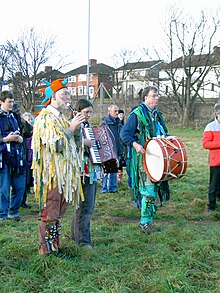Gloucestershire Wassail

Gloucestershire Wassail oder nach seinem Anfangsvers, Wassail! wassail! all over the town (Wassail! Wassail! Über die ganze Stadt) ist ein traditionelles englisches Weihnachtslied (Wassailing Lied), das wahrscheinlich aus Gloucestershire stammt.[1]
Das Lied besingt und ist Teil des alten Brauches des Wassailing (von mittelenglisch wæs hæil) bzw. Carolsingens von Haus zu Haus mit dem Wünschen einer guten Gesundheit.[2]
Seine erste Strophe lautet:
Wassail! wassail! all over the town,
Our toast it is white and our ale it is brown;
Our bowl it is made of the white maple tree;
With the wassailing bowl, we'll drink to thee.
Wassail! Wassail! Über die ganze Stadt,
Unser Toast, es ist weiß, und unser Bier, es ist braun;
Unsere Schale ist aus weißem Ahornholz gemacht;
Mit der Wassailing-Schale werden wir dir zuprosten.
Es gibt viele voneinander abweichende Textfassungen des Liedes. Das Lied wurde unter anderem von Ralph Vaughan Williams arrangiert.
![\header { tagline = ##f arranger = "Satz: Ralph Vaughan Williams" }
\layout { indent = 0
\context { \Score \remove "Bar_number_engraver" }
\context { \Voice \remove "Dynamic_engraver" }
}
global = { \key g \major \time 3/4 \partial 4 \tempo "In quick time" }
soprano = \relative c' { \global \autoBeamOff \set Staff.midiPanPosition = -0.5 \set midiInstrument = "oboe"
d4\fff | g2 g4 | g (a) b | c b a | b (d)
d | c a a | a b c | b8 [(a)] g [(a)] b4 | a2
c4 | b8 [(a)] g [(a)] b [(c)] | d2
d8 c | b4 g b | a2
g8 a | b2 a8 b | c2 b4 | a (g) fis | g2 \bar "|."
}
alto = \relative c' { \global \autoBeamOff \set Staff.midiPanPosition = 0.5 \set midiInstrument = "fiddle"
d4\pp | d2 e4 |d2 g4 | g g a | g2
g4 | e e e | d d fis | g g g | fis2
g8 ([a]) | g4 g g | a2 fis8 fis | g4 g g fis2
d8 d | g2 g8 g | g2 g4 | e2 d4 | d2 \bar "|."
}
tenor = \relative c { \global \autoBeamOff \set Staff.midiPanPosition = -1 \set midiInstrument = "clarinet"
d4 | g (b) c | b2 d4 | e e e | d2
b4 | e e c | d d d d b g | d'2
d4 | d b g | d'2 d8 d | d4 b g | d'2
d8 d | d2 d8 d | e2 d4 | c (b) a | b2 \bar "|."
}
bass = \relative c { \global \autoBeamOff \set Staff.midiPanPosition = 1 \set midiInstrument = "contrabass"
d4 | g2 g4 | g g g | c, c c | g'2
g4 | a a g | fis fis d | g g g | fis2
e8 ([fis]) | g4 g g | fis2 d8 d | g4 g g | d2
e8 fis | g2 g8 g | c,2 g'4 c,2 d4 | <g g,>2 \bar "|."
}
verse = \lyricmode {
Was -- sail, was -- sail, all o -- ver the town!
Our toast it is white and our ale it is brown;
our bowl it is made of the white map -- le tree;
with the was -- sail -- ing bowl, we'll drink to thee.
}
\score {
\new ChoirStaff <<
\new Staff
<<
\new Voice = "soprano" { \voiceOne \soprano }
\new Voice = "alto" { \voiceTwo \alto }
>>
\new Lyrics \lyricsto "soprano" \verse
\new Staff
<<
\clef bass
\new Voice = "tenor" { \voiceOne \tenor }
\new Voice = "bass" { \voiceTwo \bass }
>>
>>
\layout { }
}
\score { << \soprano \\ \alto \\ \tenor \\ \bass >>
\midi {
\tempo 4.=128
\context { \Score midiChannelMapping = #'instrument }
\context { \Staff \remove "Staff_performer" }
\context { \Voice \consists "Staff_performer" }
}
}](http://upload.wikimedia.org/score/k/d/kdvklnbm04xiekjn3bs4xeqe137e0mh/kdvklnbm.png)
Quelle[3]
Siehe auch
[Bearbeiten | Quelltext bearbeiten]Weblinks
[Bearbeiten | Quelltext bearbeiten]- „Wassail! Wassail! All Over The Town“, hymnsandcarolsofchristmas.com
- „Gloucestershire Wassail“, sniff.numachi.com
- Klangbeispiele: a, b, c, d, e, f, g, h, i (Arr. Ralph Vaughan Williams)
Einzelnachweise
[Bearbeiten | Quelltext bearbeiten]- ↑ Text und Musik “probably created 18th century” (William E. Studwell: Christmas Carols. A Reference Guide. New York & London 1985, S. 86 (Nr. 296))
- ↑ „wassail“, in: Merriam-Webster Online Dictionary
- ↑ Percy Dearmer; Ralph Vaughan Williams; Martin Shaw (Hrsg.) (1964) [1928]. „Gloucestershire Wassail“. The Oxford Book of Carols. Oxford University Press. S. 62–63.